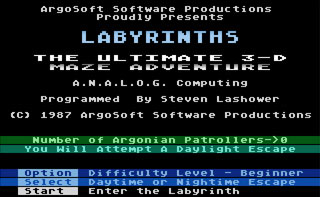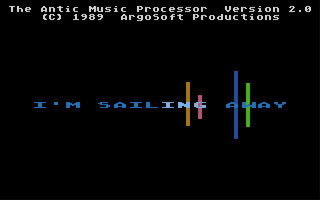
 In the Archives:
In the Archives:
So with much effort, I set out to translate the BASIC routines into 6502 assembly, which I really did not know at the time. Once in assembly, the line routines more than fast enough. So decided to spice up the display a little and added simulated texture mapping using character graphics. A friend saw the program and said that I should just try to sell it as a 3D maze game. So taking his advice, I sold it to ANALOG Magazine for a whopping $390.00. The whole project took about six months to complete.
 In the Archives:
In the Archives:
Having used Lee Actor's Advanced Music System (AMS) for years, I felt that the Antic Music Processor was the next level in step entry music sequencing for the Atari 8-bit computers. I loved Philip Price's Advanced Music Processor, and had spoken with Gary Gilbertson on a number of occasions. I liked the acronym AMP which I adapted to a title that would make Antic Magazine happy. I also liked Phil's rhythm bar motif so I wrote my own version of it.
In 1989, AMP 2.0 was released. It added lyric support (which was present in 1.0, but not supported) and a number of bug fixes. At this time, Phil was threatening to sue Antic Magazine, believing that they stole AMP from him. But once Phil learned that the only thing the two programs had in common was the playback display, he calmed down. Phil's program was never meant to be used by anyone other than Gary. Gary had told me that a Phil's AMP data file was nothing more than a collection of macros assembled with Atari's macro assembler --- which led to a very long music development cycle. If anything, the Antic Music Processor was a rip of AMS, from which it shares a common music entry language.
After AMP 2.0 was completed, I began work on AMP 3.0 which was an assembly language 128 track MIDI sequencer for the Atari ST/TT/Falcon. In addition to the rhythm bar display, AMP 3.0 had the ability to display the music on a piano keyboard in real-time - like Lee Actor's AMS. AMP 3.0 also added all the functions and commands that Lee Actor's MMS added to AMS.
In summer of 1992, I left Disneyland for Sega Interactive (a division of Sega in Diamond Bar, Ca.) where I programmed Dinosaurs for Hire, Eternal Champions, and Star Wars 32X. I started on AMP 4.0 after Eternal Champions shipped in winter of 1993. AMP 4.0 was a three-CPU music driver for the Sega CD. It supported the CD's 6-voice FM, 3-channel PCM, and 6-voice PCM. I ported over the piano display from the ST by using a program on the PC called Animator Pro (which read in .NEO files) and converted it to the Genesis character-based file format. The Sega hardware could not easily display the rhythm bars - something an 1.8Mhz 1979 piece of 8-bit hardware could easily do - so I had to use the piano display. The AMP 4.0 driver was pretty much a line-by-line port from the Atari ST AMP 3.0!
I changed the title to "Advanced Music Processor" in version 4.0, because what would Sega say if it was called the "Antic Music Processor"? I wanted to stay with the AMP acronym, and really didn't like "A Music Program", so I borrowed Phil's title - my homage to one of the best 8-bit Atari programmers ever. If you have any doubts, check out Alternate Reality - The City or Tail of Beta Lyrae. Phil was one of the first programmers I knew of who realized that music should be an integral part of a game.
AMP 5.0 followed for the Sega Genesis. Version 5.0M ("M" is for MARS, the original name for the 32X) was the music driver for Star Wars 32X. The final MC680000 version of AMP was 5.2M which was supposed to be used in some new 32X products. But due to the lackluster performance of the 32X in stores, the products were canceled.
I'm currently working on AMP 6.0 (which is really called WinAMP 1.0) a 128 track MIDI sequencer for Microsoft Windows.
 In the Archives:
In the Archives:
ASP had a number of features including: allowing more than one sample in RAM at once, the ability to play a sample backwards, and with a Hybrid Arts MIDI Interface, could turn your 8-bit Atari into a sampler. I'm not sure if the MIDI part of the program ever worked quite right.
Last Updated: Friday, March 29, 1996
Questions or comments? Contact me via: www.digital-emulsion.net